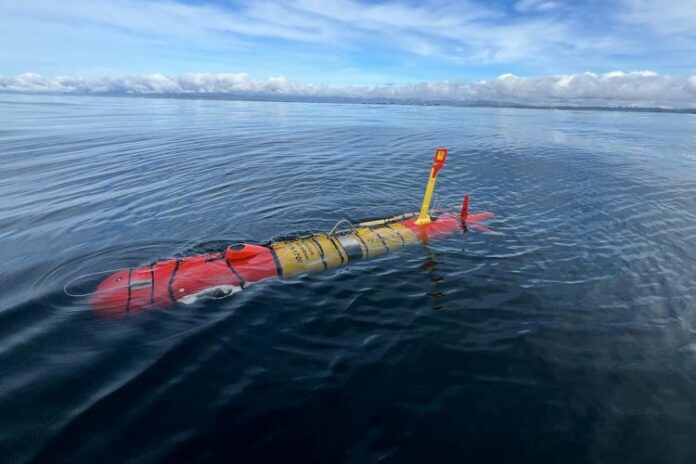Marine predators such as tunas, sharks, seabirds, and marine mammals play a pivotal role in structuring ocean ecosystems. Despite their importance, these animals remain challenging to study. They spend much of their time far from shore and dispersed across remote stretches of the global ocean. Many are highly mobile and associate with dynamic ocean habitats that change hourly and can be wary of boats and submersibles.
Now, a new camera system developed by MBARI’s engineers gives us a glimpse into the secret lives of these ocean predators. MBARI’s innovative Piscivore system can observe active ocean predators and document their dynamic surroundings.
“Marine predators are difficult to study because they’re rare, highly mobile, and the ocean is vast. The challenge is being in the right place at the right time, but now robots equipped with MBARI’s Piscivore system can give us a glimpse into the lives of tunas, sharks, and other predators, providing valuable information to better understand these important animals,” said Ocean Observatory Engineer Jared Figurski, the principal investigator for MBARI’s Piscivore project.
Tunas, sharks, seabirds, and marine mammals face an uncertain future due to threats like overfishing and climate change. We urgently need to understand these key animals so we can better protect them. Piscivore seeks to gather vital information about marine predators and their prey.
Piscivore (pronounced “pie-si-voar”) uses autonomous robots to survey marine predators far beyond coastal waters. The camera system is mounted on the long-range autonomous underwater vehicle (LRAUV), an advanced underwater robot developed by MBARI engineers. About two meters (6.6 feet) long, 30 centimeters (12 inches) in diameter, and weighing 110 kilograms (242.5 pounds), the LRAUV is a versatile platform for science. It can carry a variety of instrumentation payloads to study the ocean and its inhabitants.
MBARI engineers developed the Piscivore system to observe marine life from the perspective of this nimble underwater robot as it travels across the fertile waters of Monterey Bay.
Piscivore has two cameras—one faces ahead of the vehicle and the other watches what approaches from behind. Many predators move out of the way of animals and objects that approach them. Piscivore compensates for the skittishness of pelagic predators by dragging a piece of textured metal in its wake. As the metal attractor swirls in the currents, it catches sunlight and flashes like a silvery fish, piquing the curiosity of predators. The cameras record continuously to see who approaches.
MBARI researchers pilot the LRAUV remotely from our facilities on shore using cellular and satellite data connections on the vehicle. They can target hotspots of ocean productivity where food is plentiful and predators will be most abundant, then send Piscivore in for a closer look.
Researchers deploy Piscivore for roughly two weeks at a time. After its mission is complete, MBARI’s marine operations crew retrieves the vehicle and downloads the camera data on shore. Each deployment logs approximately 200 hours of high-definition video, 100 hours from each of Piscivore’s two cameras. Machine-learning algorithms developed by MBARI’s software engineers leverage the power of artificial intelligence to help researchers quickly review and catalog Piscivore’s observations.
“Our team is interested in understanding the relationships among ocean animals. We use sound to map life in Monterey Bay using robots to tell us how many of what types of animals are where. Using sonar alone, however, it is difficult to identify specific species. Piscivore fills that gap, giving us a new window to understanding predator-prey relationships,” said Senior Scientist Kelly Benoit-Bird, who leads MBARI’s Acoustical Ocean Ecology Team.
Piscivore also gathers visual data about the “neighbors” that live alongside ocean predators. It films the gelatinous animals that live in the open ocean and have historically been challenging to study.
“One thing Piscivore shows us is that the best way to gain insight on what is happening in the open ocean is to spend more time out there and cover more area. Ships and deep-diving robots gather detailed data from specific, targeted locations, but Piscivore can collect data for weeks at a time across the open sea,” said Senior Scientist Steve Haddock, who leads MBARI’s Biodiversity and Biooptics Team.
Haddock and his team are interested in studying how populations of gelatinous animals ebb and flow. They use a variety of approaches to get a grasp on the dynamics of jelly blooms, including robot-mounted cameras, above-water drones for photographing the sea surface, and community science observations through JellyWatch.
“Piscivore is an important new tool in our belt. It’s exciting to be operating in a time when there are so many options besides dragging a net behind a large ship,” said Haddock.
But Piscivore is much more than a camera—it is an innovative sensor system for studying the open ocean.
MBARI’s LRAUV carries a suite of environmental sensors inside its housing. During Piscivore deployments, the host vehicle collects information about the physical surroundings. The LRAUV logs data about ocean salinity, temperature, chlorophyll, oxygen, and chemistry. These data provide valuable context about the environments that ocean predators frequent.
“Offshore, or pelagic, marine habitats are constantly changing, shifting and traveling with the currents, as are the species that associate with those habitats,” explained Figurski. “To fully understand just how dynamic ocean habitats are, imagine going to bed looking at a forest of trees in your backyard, then waking up to find those trees and all of the other plants and animals are now 10 miles away. This is the challenge we face when trying to study mobile marine predators in the open ocean. The solution requires technology that allows us to efficiently survey vast expanses of the ocean.”
MBARI engineers are currently developing new capabilities for the sensor suite. Ongoing research and development aims to add on-board AI for real-time video analysis, new attractors, stereo imaging cameras capable of estimating the sizes of animals captured on video, and complementary environmental DNA (eDNA) sampling.



